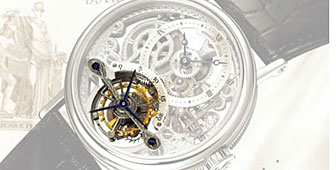Versailles toasts Breguet’s “tourbillon”

A major innovation by Switzerland's king of watchmaking, Abraham-Louis Breguet, has been celebrated at Versailles.
A grandiose evening reception at the château of Versailles was organised to pay tribute to one particular Breguet invention which is 200 years old – the “tourbillon”, one of the classical complications in horology.
In a nutshell, the “tourbillon” is a device whose regular rotations effectively cancel the negative effects of the pull of gravity on the rate of mechanical watch movements.
The “tourbillon” contributed in no small part to Breguet’s reputation and continues today to fascinate watchmakers and lovers of complicated watches.
The celebrations had been planned for last year – to coincide with the 200th anniversary of the “tourbillon” – but were cancelled after the September 11 attacks.
Granting of a patent
Breguet was awarded a patent for his new type of regulator by the French interior minister on June 26, 1801 or rather the 7th of Messidor, Year IX, according to the French Republican calendar then in force.
Some 600 guests from the world of art, politics and business will be celebrating in Versailles the 200th anniversary of the granting of the patent for the “tourbillon”.
Until two years ago, the Breguet watch company was known for its past achievements but was a slumbering concern.
That changed dramatically when the Swatch Group, Switzerland’s largest watchmaking concern, acquired Breguet in September 1999 and added it to Blancpain and Omega at the luxury end of its brand names.
Watchmaking pioneer
The head of the Swatch Group, Nicolas G Hayek, has personally guided the Breguet company since its integration into his empire, not missing an opportunity to laud the talent of a watchmaking pioneer whose achievements are still widely acknowledged.
Under Hayek’s leadership, Breguet’s production facilities have received major investments designed to increase manufacturing capacity to cater more efficiently to growing demand from some of the world’s most demanding customers.
The power of marketing today will force potential customers to recognise that Breguet has an enduring fascination, consolidating over the years its reputation as a model of luxury, refinement and creative genius.
Delving in the archives of sales of Breguet timepieces over the past 225 years, owners include Napoleon Bonaparte, Winston Churchill and Arthur Rubinstein.
Literary giants
A few literary giants have also saluted the art of Breguet and his successors, including Stendhal, Balzac, Pushkin, Alexandre Dumas, Max Jacob and, more recently, Patrick O’Brian.
Born in Neuchâtel in 1747, Breguet arrived in France at the age of 15, spending his early years in Versailles, where the kings of France then resided and where he was to effect part of his apprenticeship.
In 1780, he produced the first self-winding watches known as “perpétuelles”, conceived the “pare-chute” system that provided the forerunner of shock-protection devices in 1790, and from 1810 and 1812, made the first know wrist-worn watch.
Monday’s “tourbillon” celebrations will come to a climax with a spectacle of water and light in the château gardens, with a musical show accompanied by fireworks.
The finest specimens of Breguet antique and period watches will be on display till June 8 at the Breguet Museum and Breguet Boutique, located at 20 Place Vendôme in Paris.
by Robert Brookes

In compliance with the JTI standards
More: SWI swissinfo.ch certified by the Journalism Trust Initiative
You can find an overview of ongoing debates with our journalists here. Please join us!
If you want to start a conversation about a topic raised in this article or want to report factual errors, email us at english@swissinfo.ch.